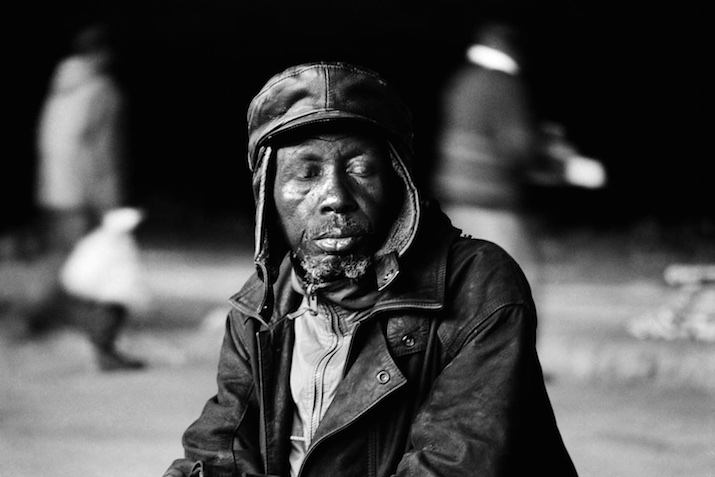A Metaphorical Biography
Santu Mofokeng’s photographs keep you wanting to know who are these people, what's their sophistications, and what's going to happen to these aspirations?

Photograph by Santu Mofokeng (Walther Collection).
Santu Mofokeng’s photographs and work as a photographer have been at the center of South Africa’s historiography and its representation. In part, scholars and activists have used his pictures to both document and analyze anti-apartheid struggle in South Africa and the significance of the “documentary” power of photographs in such struggle. Mofokeng himself much later spoke in numerous interviews to how he was attempting to photograph something different from his contemporaries and to challenge the notion of the “documentary’ that existed at the height and end of the anti-apartheid struggle. “A Metaphorical Biography,” the title of an exhibition of his work at the Walther Collection’s NY Project Space, is an ode to reflect on Mofokeng’s efforts to photograph what he “ordinarily sees.”
Furthermore, archiving efforts, like his “The Black Photo Album,”(compiled from the photo albums of black South Africans at the turn of the 20th century) questioned stereotypes of South Africans, and Africans more generally, by using portraiture (a popular medium in practice and study) to inquire about the notion of middle-class aspirations. Thus, the displayed works are pieces of art as much as they are methodological ruminations on photographic discourse around South Africa and Africa more broadly—the very ways the public sees and understands events in and around Africa.
The exhibition features widely viewed photographs by Mofokeng, which the Walther Collection owns and includes: “Train Church” (1986), “Townships” (1985-2006), “Rumours: The Bloemhof Portfolio” (1988-1994), “Landscapes of Trauma” (1996-2008), and “Climate Change” (2007). Some series like “Train Church”, which feature the transformation of cramped train cars during daily commutes into hubs of spiritual readings and performances, and Climate Change, which includes scenes of a dust storm, a damn, and a beach, are from one specific year. Whereas, in Townships” and “Rumours: The Bloemhof Portfolio”, Mofokeng explores the interior and exterior worlds of life in townships in the apartheid and post-apartheid periods. The exhibition’s temporal coverage is vast. But, this span of time is also revealing for the types of questions that Mofokeng’s pictures present before South Africa’s historiography, his photographed subjects, and the viewers of his images and how these questions (and also commentaries on them) unfold over time through the collection and exhibition of his works. For instance, in “The Black Photo Album,” Mofokeng includes a slide in reference to previously displayed portraits:
Who were these people?
What were their sophistications?
What is going to happen to these aspirations at the end of the twentieth century South Africa?
Although specific to the pictures included in “The Black Photo Album,” such a query also travels with a visitor to “A Metaphorical Biography” and is something that the visitor is forced to grapple.
One experiences an eerie and ominous felling walking into the Project Space partly because during its short run, the “A Metaphorical Biography” has, perhaps for lack of a better word, witnessed protests advocating the removal of Rhodes’s statue at the University of Cape Town and xenophobic killings in South Africa. Not necessarily unrelated, Europe is now contemplating what to do about the countless migrants from Africa and the Middle East who have drowned in its seas. Discussion of these events has been the focus of “Africa is a country” and other news and social media feeds, but few, if any have discussed he photographic images that have come out of these events or that are used as stand-ins to document and explain them.
In one respect, the exhibition displays the very spaces and peoples whose lives lie at the center of apartheid and the anti-apartheid struggle and whose lives continued to be affected by the xenophobic killings in South Africa and discussions underway from within European parliaments. In another respect, the photographs force visitors to give greater thought to spaces, such as road signs, sheebens, train cars, and building architecture, previously dismissed as insignificant or overlooked. But, there are also landscape scenes that were the very spaces that the apartheid regime used to defend itself internally and also against South Africa’s neighbors. In “Landscape’s of Trauma,” Mofokeng revisits these sites of struggle to consider South Africa’s memorialization of these places in the post-apartheid period. These photographed spaces, in addition to the trauma they come to embody through photographs of them, are at play again today in unsettling ways. For example, how is one left to think about South Africans’ killing and destroying of property of African migrants who come from the very nation’s South Africa relied on to end apartheid (see Mia Couto’s letter to Jacob Zuma)?
In light of recent events in South Africa and Europe, Mofokeng’s photographs keep visitors wondering and wanting to know the answers to a question he posed in “The Black Photo Album”: who are these people, what are their sophistications, and what is going to happen to these aspirations in the future?





